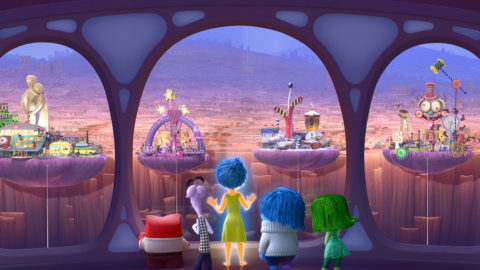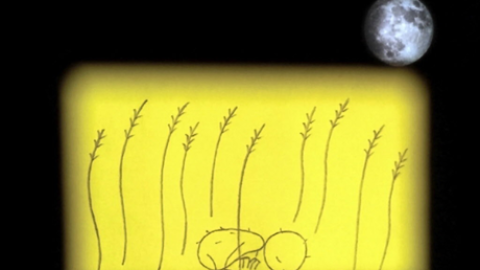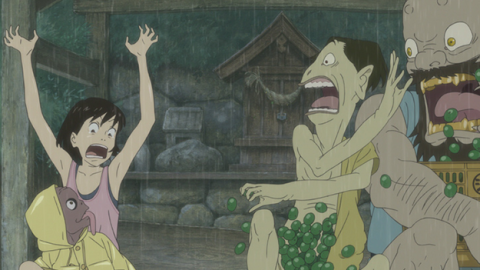Film of the Week: The Good Dinosaur
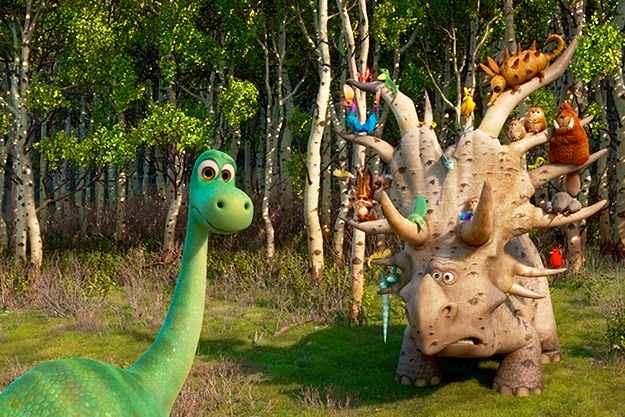
Whether or not Pixar films have great stories to tell, whether or not they succeed in wringing childlike tears from the most hardened viewers, the studio can always be relied upon for one thing: it is surely cinema’s most advanced research-and-development unit for aesthetic effects. It’s hard to think of a Pixar production, even among the feebler ones, that doesn’t offer at least one significant breakthrough or refinement in terms of a specific visual challenge: water in Finding Nemo, the organic-metallic sheen of insect wings in A Bug’s Life, fur in Monsters, Inc., the color red in The Incredibles…
The good news about The Good Dinosaur is that it doesn’t disappoint on this purely plastic level, in one realm at least. This film goes further than any other CGI animation I can recall in its exploration of the natural world; it evokes its idealized vision of Nature as wholeheartedly as any lyric poet of the 19th century. The heart and soul of The Good Dinosaur can be found in the series of single images seen at the start of its end credits: leaves, grass, mountains, water…
Where Marianne Moore famously characterized poems as “imaginary gardens with real toads in them,” The Good Dinosaur succeeds in creating a real garden—a photo-real garden—a photo-real Eden, indeed. The film’s vistas of an unspoiled, presumably North American continent are magnificently conceived. It’s the toads—and the rest of the creatures, saurian or other—that are the problem. It’s not just that there are no interesting characters in The Good Dinosaur, it’s that director Peter Sohn and his crew seem scarcely to have bothered with nuanced characterization. For example, the daddy T. Rex encountered late in the film has barely any facial expression, and the entire job of giving this anthropomorphic creature a personality is entrusted to the familiar basso growl of Sam Elliott, instantly infusing the beast with the codes of the cowboy movie (the T. Rexes are ranchers, tending great flocks of longhorn cattle; the cattle drive itself, to be fair, does look great).
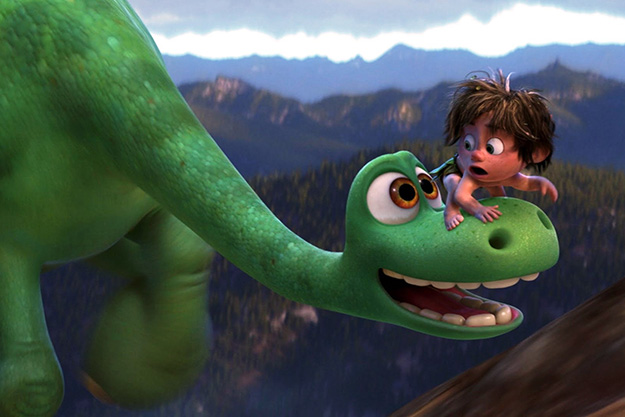
Nor is plucky green hero Arlo (voiced by Raymond Ochoa) much to look at. He’s a gangling, more elastic version of his parents and siblings, with a blocky head, outsize eyes and teeth, nostrils that look as if someone poked a little finger into plasticene, and a sleek, rubbery exterior—as designed specifically to be easily reproduced in toy form. Presumably it was an express decision to make Arlo simple, in order to play up the textural complexity of his environment; presumably there’s also a conscious homage to the roots of animation, to Winsor McCay’s affably lanky Gertie the Dinosaur from the 1910s.
The Good Dinosaur harks back to origins in all sorts of odd ways. The premise is pitched neatly in a concise prelude, set 65 millions of years ago: a gorgeously evoked asteroid belt, in which one rock nudges another, and sends it flying towards Earth. On our planet, grazing long-necked dinosaurs look up at the fireball in the sky—then go back to munching, as the meteor passes by. Millions of years later, we’re on a different earth from the one we know: dinosaurs have not evolved significantly in form, apart from acquiring American speaking voices, and inhabit a verdant landscape that has never been spoiled by industrialization. A mom and dad dinosaur (voiced by Frances McDormand and Jeffrey Wright) tend their field of corn, stack corncobs in a stone silo, and watch as their three eggs hatch out. Arlo, the youngest baby, emerges from a huge egg that is absolutely empty, with no traces of any kind of organic matter or goo—a bizarre denial of physicality that sets the tone for this film’s abstracted, idealized, and altogether non-threatening vision.
So, millions of years after avoiding destruction, dinosaurs have not in fact created a quasi-human civilization of their own (no Jurassic variation on Monsters, Inc. here, which presumably would have given us something like the Dinotopia series). Instead, they’ve just reached this gentle, ecologically undisruptive agrarian culture, which—given the folksy fiddles and hoedown themes of Jeff and Mychael Danna’s score—we’re supposed to see as an ideally balanced state of American ruralism.
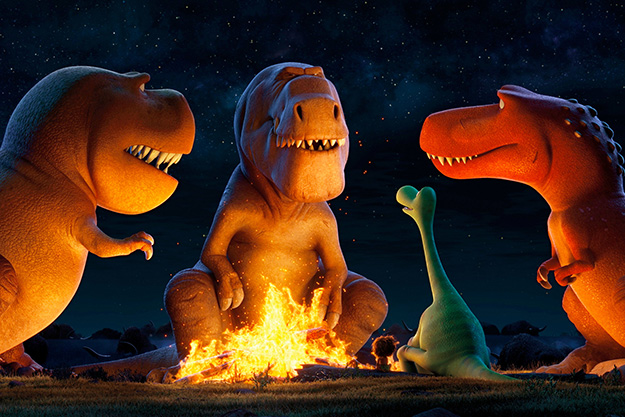
The dinosaurs don’t seem to inhabit any wider social structure: they’re an entirely isolated family cell. So any contact that Arlo later makes with the wider world—on the odyssey that will help him conquer his fear and “see the beauty on the other side,” as his dad puts it—is bound to be traumatic for him. Bambi was part of a herd; even Dumbo knew the other circus animals.
Written by Meg LeFauve, with her, Sohn, and others credited on story, The Good Dinosaur features the most mundane narrative of any Pixar film—mundane because it so blatantly aspires to mythic resonance. It mixes coming-of-age story and survival odyssey, with manifest echoes of Dumbo, Bambi, and The Lion King: its hero gets lost in the Big World following the death of a parent (for which, in this case, he feels directly responsible), and learns about the world and himself through a comical helper. Where Dumbo had Timothy Mouse, Arlo has a small human—a Neanderthal child in leaf nappies. Originally a “critter” he vows to eliminate, the child becomes a pet: Arlo names it Spot. Ironically, given that you’d expect this film to be about everything but the human factor, Spot is its liveliest presence: part Mowgli, part Tasmanian Devil, a joyously inventive spirit of feral mischief.
Spot also, in the film’s most lachrymose moment, shares its (his?) own loss, and helps Arlo discover the meaning of the nuclear family and home, by creating a little model with sticks and soil. The curious variation to this conservative return-to-home narrative is that it’s motivated by Arlo’s need to make a mark—literally. If he manages to achieve something big, then he’ll get to add his own muddy pawprint to the wall of the family’s corn silo. Semiotically inclined Disneyologists may have a field day with this (“The Post-Jurassic Self and the Search for Signature”), but for most of us, this payoff will feel unmomentous, and a little unpleasant—as if it’s only by achieving a major feat that the runt of the litter can earn the right to belong to the family, or the outsider to society.
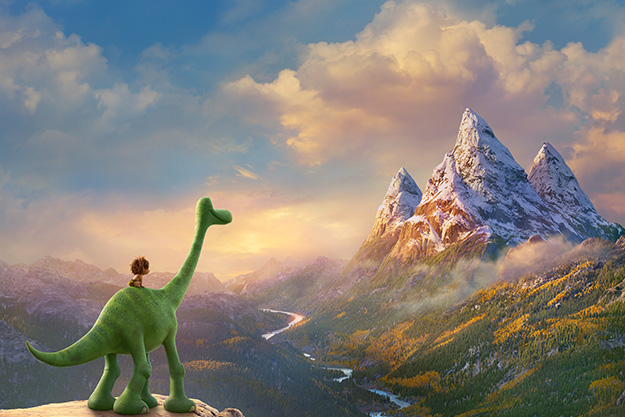
The Good Dinosaur is known to have been a troubled production, with original director Bob Peterson (Up) being replaced by Sohn, who made the 2009 short Partly Cloudy. There are odd inconsistencies along the way, as if the film were marked by the signs of its own troubled evolution. There are momentary eccentric shifts of tone, such as a brief, underdeveloped sequence in which Arlo and Spot change shape after chomping hallucinogenic fruit (perhaps truncated because it couldn’t match the all-out weirdness of the “abstract thought” sequence in Inside Out). There’s also a moment when a whole chunk of glaringly eccentric script seems to been dropped in for the only time in the film. This features a cross-eyed, tree-like dinosaur, its antlers full of grandiosely named pets, which he introduces one by one: “This is Dreamcrusher—he protects me from having unrealistic goals.” Cut to a little red bird: “This is Debbie.”
There are some nice inventive sequences—an extended gag about blowing chipmunks out of holes, a sight gag that plays on Jaws, only upside down, in the clouds—and some interesting ideas about evolutionary paths never traveled (four-legged serpents, giant insects). But altogether, The Good Dinosaur feels like a patchy suite of numbers, rather than an organic film. With its prehistoric comic invention, the heads-down slapstick of the Ice Age series is a lot more fun.
This is also the only Pixar film I can think of that feels pious. It’s as if the Pixar think tank had looked at Terrence Malick’s Tree of Life and decided that it would have been a lot better if it had concentrated on the big lizards instead of the Texans. The nuclear family stuff is very icky, and the ideology seems designed to reassure conservatives: don’t worry about evolution, because whatever path history could have taken, it was all fated to end up with some version of a quasi-human nuclear family living in a paradisiacal America.
What I can commend is those heightened touches of abstract beauty that emerge from the film’s evocation of nature: the green glow of fireflies in a blue night, the swirls of waving grass, a dash through a field of white wading birds. This might seem small consolation after Inside Out, a film that’s utterly brazen in its mischief, invention, and sophistication, although The Good Dinosaur is clearly pitched at a younger, less discerning audience. Still, it’s commendable that a studio specializing in the most complex forms of technological, immaterial artifice should decide to make a film that will alert today’s children to the wonders of natural landscape. When did you last see a film not made by Apichatpong Weerasethakul that took time to revel in the textures of foliage?



